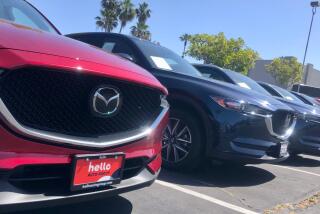Yenâs Rise Puts Japanâs Car Makers in a Bind : Trade: Purchases of American-made parts are likely to fall below targets set for 1994-95.
TOKYO â The yenâs rise against the dollar is clouding the prospect for bigger Japanese purchases of U.S. auto parts and forcing car makers to raise overseas production sharply, government and industry officials said Monday.
An official with the Ministry of International Trade and Industry said U.S. auto-part purchases by Japanese companies rose a hefty 29.4% during the 1992-93 fiscal year, which ended March 31.
Total purchases by 11 Japanese auto makers totaled $13.6 billion, representing U.S. parts and materials exported to Japan as well as those bought in the United States for use in American-based plants.
The sale of U.S. auto parts to Japanese car makers is a top trade issue for American policy-makers, who want Tokyo to cut its $50-billion trade surplus with the United States by importing more American-made products.
In early 1992, Japanâs auto industry announced plans to raise annual U.S. auto-part purchases to $19 billion by the end of the 1994-95 fiscal year, which begins next April.
But the MITI official warned that the stubborn rise in the yen and Japanâs economic recession have clouded the industryâs ability to meet that target.
âIt is difficult to foresee, in view of the strong yen and sluggish domestic vehicle demand,â said the official, when asked if Japanese car makers would be able to buy $19 billion in U.S. parts next year.
âThey have been doing their best to achieve the target,â he added.
The yen has reached successive post-World War II highs against the dollar despite efforts by the Bank of Japan and the Federal Reserve to undercut its gains.
Japanese auto industry data shows the yenâs strength pushing car makers to speed up a shift in production to overseas sites, including those in the United States.
Higher foreign production has long been a goal for most companies. But the sharply rising value of the yen has made the situation more urgent.
The Top Five car makersâ collective overseas production in the current fiscal year, which ends next March 31, is expected to rise 17% to 3.52 million vehicles. Exports are expected to fall about 5.4% to 4.40 million vehicles.
Domestic sales are seen rising a collective 4.5% to 5.41 million, after an unprecedented two-year decline.
The figures became available after Nissan Motor Co., Mitsubishi Motors Corp., Honda Motor Co. and Mazda Motor Corp. released financial results for the 1992-93 fiscal year.
The sole exception to the trend in higher overseas production is Honda, whose complete remodeling of the Accord will result in lower production in the United States this year.
Calculating the local content of cars produced by Japanese companies overseas is a contentious issue. But industry officials say some of the more localized production facilities use about three-quarters local content.
More to Read
Inside the business of entertainment
The Wide Shot brings you news, analysis and insights on everything from streaming wars to production â and what it all means for the future.
You may occasionally receive promotional content from the Los Angeles Times.










